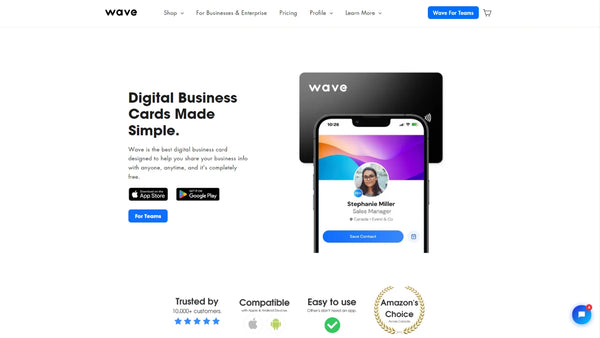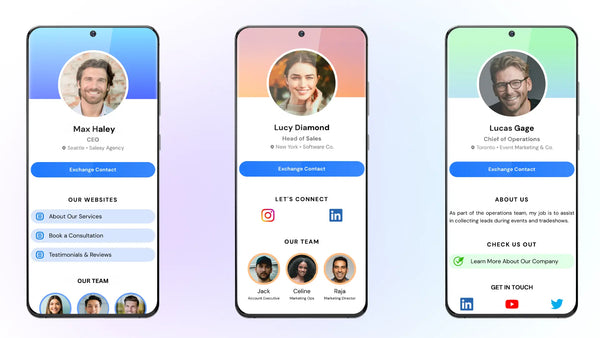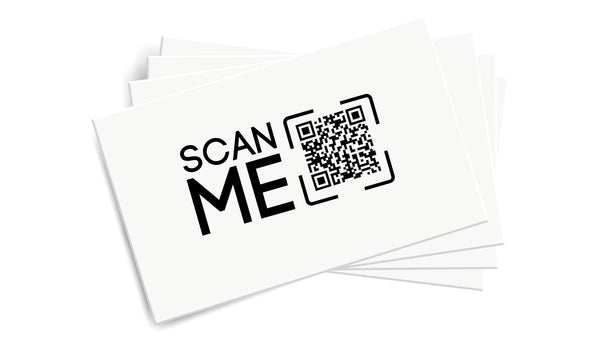How To Add a QR Code to Your Business Card (In 4 Steps)

So, you're looking to add a QR code to your digital business card, right? Paper business cards have been our networking buddies for ages. But let's face it, they can feel a bit old-school and don't leave much room for all the awesome stuff we want to share.
Adding a QR code to your business card is a powerful way to improve your networking and marketing efforts. QR codes, short for Quick Response Codes, can link to various types of digital content, such as your website, contact information, or even a digital business card.
By integrating a QR code into your business card, you modernize your card and provide an easy way for contacts to access your digital presence. Here's a step-by-step guide on how to add a QR code to your business card:
1. Create a Wave digital business card account

The first step is to create a free digital business card.
Don't worry, we'll automatically generate a QR code that you can add to your paper business card.
2. Customize your digital profile

The next step is to customize your digital business card to fit your brand and company style. You have the option to add as much information as you'd like, but make sure it's relevant to your target audience and potential customers.
3. Download your Wave QR code

Now that you have the best networking tool in your arsenal, you'll need to download your QR code. Click on the "blue QR code" icon near the bottom center of the mobile screen and click "download QR code." For Desktop, click the "share your profile" icon near the top right corner of the screen to download your QR code.
4. Print your business card with the QR code

Lastly, add the QR code to your paper business card to provide your potential customers with an extra layer of online information.
Make sure to choose a reputable printing service to print your business cards. Ensure the print quality is high so that the QR code is clear and easily scannable.
Alternatively, instead of exchanging paper business cards, you can simply share your digital business card with a QR code. Your new contact can scan the code and be directed to your online profile, where they can easily save your contact information, visit your website, and follow you on social media. This eliminates the need for paper and makes the whole process more convenient for everyone involved.
6 Reasons To Add QR Code to Your Business Card

Adding a QR code to your business card isn't just cool; it's a smart move for your networking and branding game. Let's break down the top six reasons this little change can make a big impact.
1. To Make it More Relevant
Adding a QR code means your business card just got a digital upgrade. It's like saying, "Hey, I'm with the times!" With a quick scan, folks can jump straight to your online world, making your card a bridge to a deeper connection.
When recipients scan the QR code, they can quickly access your website, LinkedIn profile, or other online platforms, allowing them to connect with you and your business digitally. This ensures that your business card remains pertinent in an era where most business interactions happen online.
2. To Share More Information
We've all struggled with the limited space on traditional cards. But with a QR code, you're unlocking a treasure chest of info. From detailed contact info to your killer portfolio, it's all just a scan away. Plus, updating your info is a breeze, keeping your card forever fresh.
3. To Create a Lasting Impression
Handing over a card with a QR code says you're all about innovation. It's a statement piece that sets you apart and sticks in people's minds long after the first handshake.
4. To Update Information Easily
Changed your number? Got a new role? No sweat. Update the info behind your QR code without the hassle of reprinting. It's not just smart; it's eco-friendly and cost-effective.
5. To Be More Creative
Your business card can be a mini canvas. Embed your QR code into your design in cool, unexpected ways that capture attention and showcase your creativity.
6. To Collect Valuable Market Data
QR codes are like secret agents gathering intel. Track scans to see which interactions turn into connections, helping you fine-tune your networking strategy and measure the impact of your outreach.
You can use QR codes to encourage customers or contacts to participate in surveys, contests, or feedback mechanisms, enhancing your market research and engagement with your audience.
Things to consider when adding a QR code to your business card design.

1. Relevance
Before adding a QR code to your business card, it's crucial to consider its relevance to your professional goals.
The QR code should direct recipients to valuable content, whether it's your website, LinkedIn profile, or digital portfolio.
Think about what information would be most useful for your target audience.
For instance, if you're a photographer, linking to a gallery of your work can be more impactful than simply sharing your contact details. Make sure the linked content is up-to-date and aligns with your brand.
QR codes can also be used strategically for various purposes, such as event promotions, social media engagement, or product launches.
Knowing the purpose of the QR code and how it aligns with your current business objectives is important. This ensures that the QR code serves a practical function and isn't perceived as an unnecessary gimmick on your business card.
2. Sizing
The size of the QR code on your business card is crucial for ensuring its functionality. If the QR code is too small, it might become challenging for people to scan it with their smartphones. On the other hand, if it's too large, it could disrupt the overall design aesthetics of your business card.
Typically, a QR code of around 1x1 inch or 2.5x2.5 cm is a suitable size.
When determining the QR code's size, remember that it should be easily noticeable, yet it shouldn't overshadow the essential contact information or design elements on your business card. It's recommended to print a sample card with the QR code at different sizes to find the right balance.
3. Design Integration
You can customize the QR code's color to match your brand's palette or opt for a minimalist black-and-white design.
Consider placing the QR code in a strategic yet non-obtrusive location, such as the back of the card or a corner. It should complement your card's overall aesthetic.
Remember that QR codes can be surrounded by a "quiet zone," which is a margin of space around the code. This space ensures that the code can be scanned without interference.
Ensure that your card design accommodates this quiet zone, and don't clutter the area around the QR code with text or other graphics.
4. Include Instructional Text
While QR codes have become more common, including brief instructional text near the QR code is still a good practice.
Instructional texts like "Scan with your smartphone" or "Scan for more information." This guidance can be particularly helpful if your card's recipients are not tech-savvy. It ensures that they understand how to use the QR code effectively. Keep this text clear, concise, and in a legible font that matches your card's style.
5. High Contrast
To ensure optimal scanning, the QR code itself should have high contrast. A black QR code on a white background or vice versa is a standard and reliable choice.
High contrast ensures that smartphone cameras can easily distinguish between the code and the background. Avoid using busy or complex backgrounds that might interfere with the QR code's legibility.
6. Scan Location
Consider the practicality of the QR code's placement when designing your business card. It's best to put the QR code in a location that's easy for recipients to scan with their smartphones.
The back of the card is a common choice because it provides a flat surface, making it easier to scan. Avoid placing the QR code near the card's edges or corners, as it may be challenging to capture the entire code in the frame.
Digital Business Card QR Codes & Generators

In recent times, there has been a notable trend that is gaining popularity, which involves using QR codes on both digital and traditional paper business cards. This trend has emerged in response to the growing need to create a seamless connection between the tangible, offline world of business cards and the vast digital realm.
Traditionally, business cards were a simple piece of cardstock with basic personal information. However, with the inclusion of a QR code, business cards have evolved into a powerful gateway to various digital platforms. A QR code makes it possible to transform a static piece of paper into a dynamic link to online resources such as social media accounts, personal websites, and LinkedIn profiles.
By scanning these dynamic QR codes using their mobile devices, users can instantly access a digital space filled with immersive and interactive mobile marketing content. This content provides a comprehensive view of your brand and profession, offering potential contacts a more engaging experience.
Customizing your QR code to align with your overall branding elements is crucial. This customization adds a touch of personalization and ensures that your QR code seamlessly integrates with your existing marketing materials and branding strategy.
In the past, generating QR codes was challenging and required specialized IT and programming skills, making it difficult for the average professional. However, the landscape has since changed, and now it's easier than ever to create QR codes. You can use readily available QR code generators to produce QR codes tailored to different content types. This versatility allows you to expand your reach by adding QR codes to marketing materials, making it easy to share contact information such as phone numbers and email addresses.
Conclusion
The addition of a QR code to your business card can be a game-changer for your networking efforts, enabling you to share a wealth of information with ease. However, it's crucial to ensure the link works correctly and directs your connections to the right platform.
Switch to Wave's innovative digital business card platform to seamlessly integrate free QR codes into your networking strategy.
The best part is that your recipients won't require a separate QR code scanner app. They can use their mobile phone camera to scan the QR codes and instantly access your information.
About The Author






